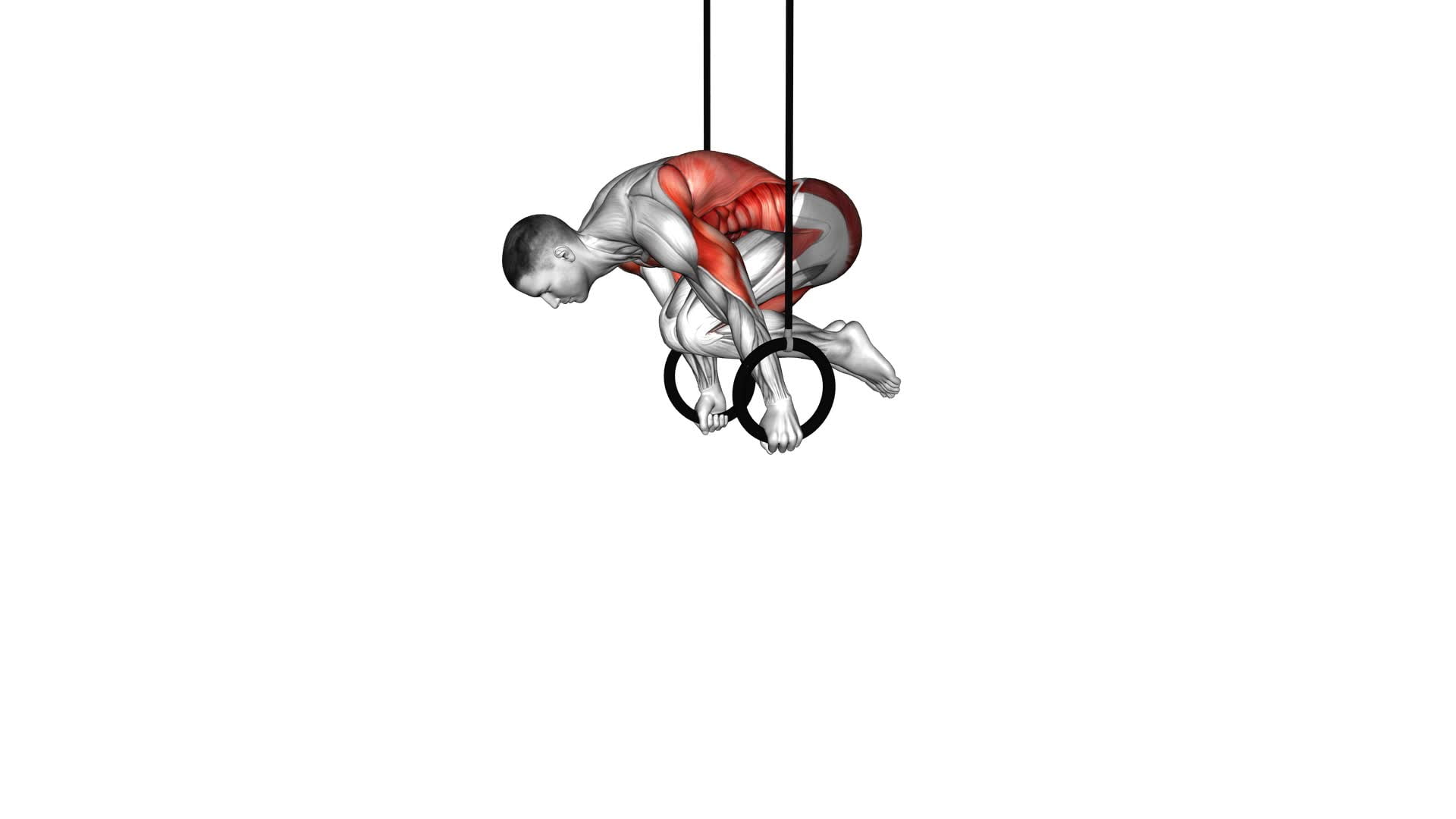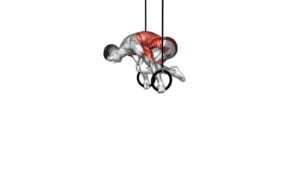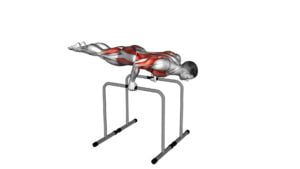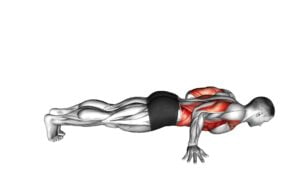Ring Planche (male) – Video Exercise Guide & Tips

Are you looking to master the ring planche?
Watch This Exercise Video
This video exercise guide is here to help you out! With step-by-step instructions and helpful tips, you'll learn the proper form and technique for this challenging exercise.
Whether you're a beginner or an advanced athlete, this guide has progression exercises and advice to suit your level.
Get ready to strengthen your core, build upper body strength, and take your fitness to the next level with the ring planche.
Let's get started!
Key Takeaways
- The ring planche targets and strengthens core muscles while increasing shoulder stability.
- Proper form and technique are crucial, including maintaining a straight body position, engaging the core and shoulder muscles, and avoiding sagging or rounding the back.
- Beginners should start with mastering the basic plank position on the rings, gradually raising their feet off the ground, and shifting more weight onto their hands and shoulders.
- Common mistakes to avoid include improper hand placement on the rings, lack of core engagement, insufficient forward lean, rushing the progression, and neglecting shoulder and wrist mobility work.
Benefits of the Ring Planche
The ring planche offers several benefits for improving your upper body strength and stability. By incorporating this exercise into your routine, you can effectively target and strengthen your core muscles, leading to improved overall core strength. Additionally, the ring planche is highly effective in increasing shoulder stability, as it requires you to engage and stabilize your shoulder joints throughout the movement.
When performing the ring planche, you're required to maintain a straight body position, with your arms fully extended and your feet off the ground. This position places a significant demand on your core muscles, forcing them to work hard to keep your body stable. Over time, this will lead to increased core strength, which is essential for various athletic activities and everyday movements.
Moreover, the ring planche also challenges your shoulder stability. As you balance your body weight on the rings, your shoulders are engaged to maintain proper alignment and control. This not only strengthens the muscles surrounding your shoulder joints but also improves their stability, reducing the risk of injuries.
Incorporating the ring planche into your workout routine can provide numerous benefits, including improved core strength and increased shoulder stability. By consistently practicing this exercise, you can enhance your upper body strength and stability, leading to better overall fitness and performance.
Proper Form and Technique
To ensure proper form and technique during the ring planche exercise, you should focus on maintaining a straight body position and engaging your core and shoulder muscles throughout the movement.
One common misconception when performing the ring planche is that you need to rely solely on your arm strength. However, this exercise requires a strong core and shoulder stability as well. By keeping your body straight, you activate your core muscles, which helps stabilize your body on the rings. Engaging your shoulder muscles is also crucial for maintaining a controlled and balanced position.
Another important aspect of proper form is to avoid sagging or rounding your back. This can put unnecessary strain on your lower back and increase the risk of injury. Instead, focus on keeping your back straight and your hips in line with your shoulders.
Injury prevention techniques for the ring planche include warming up properly before the exercise and gradually progressing in difficulty. It's also crucial to listen to your body and not push through any pain or discomfort.
Progression Exercises for Beginners
To progress as a beginner in ring planche exercises, focus on mastering the basic plank position on the rings. This foundational exercise will help you build core strength, which is essential for performing more advanced variations of the ring planche.
Start by adjusting the rings to a height that allows you to comfortably place your feet on the ground while holding onto the rings with your hands. From there, assume a plank position, with your arms fully extended and your body in a straight line. Engage your core muscles and hold this position for as long as you can.
As you become more comfortable and stronger, you can gradually increase the difficulty by raising your feet off the ground, shifting more weight onto your hands and shoulders. This modified variation will challenge your core muscles even more and help you progress towards the full ring planche.
Remember to always maintain proper form and technique to avoid injury and maximize your progress.
Common Mistakes to Avoid
Avoid these common mistakes when performing ring planche exercises to ensure proper form and maximize your progress. Here are some technique tips to help you avoid these errors:
- Improper hand placement: Placing your hands too far forward or too far back on the rings can throw off your balance and make it difficult to maintain the correct body position. Make sure your hands are centered on the rings and positioned slightly wider than shoulder-width apart.
- Lack of core engagement: Failing to engage your core muscles can result in a sagging lower back and a loss of stability. Keep your core tight throughout the exercise to maintain a straight body line.
- Not leaning forward enough: The key to a successful ring planche is leaning forward enough to shift your weight onto your hands. If you don't lean forward sufficiently, you may struggle to lift your feet off the ground.
- Rushing the progression: It's important to progress gradually when training for the ring planche. Skipping steps or rushing the progression can increase the risk of injury and hinder your progress. Take your time and build a solid foundation before moving on to more challenging variations.
- Neglecting mobility work: Adequate shoulder and wrist mobility is essential for performing the ring planche safely and effectively. Incorporate mobility exercises into your routine to improve flexibility and prevent injuries.
Tips for Advanced Athletes
If you're an advanced athlete looking to further challenge yourself on the ring planche, focus on refining your technique and pushing your limits.
Advanced training for the ring planche involves incorporating variations to make the exercise more challenging.
One variation you can try is the straddle ring planche. In this variation, instead of keeping your legs straight and together, you spread them apart into a straddle position. This requires increased strength and stability in your upper body and core.
Another variation is the tuck planche push-up on rings. Start in a tuck planche position, then lower yourself into a push-up, maintaining the tuck position throughout the movement. This variation not only strengthens your upper body but also improves your overall stability and control.
As an advanced athlete, it's important to listen to your body and progress at a pace that's challenging but safe. Always warm up properly before attempting advanced variations and make sure to maintain proper form to prevent injuries.
With dedication and consistent practice, you can continue to improve your ring planche skills and take your athleticism to new heights.
Frequently Asked Questions
How Long Does It Take to Master the Ring Planche Exercise?
To master the ring planche exercise, it's important to progress gradually. Start by building your upper body and core strength through exercises like push-ups and planks.
Once you feel confident, begin practicing the ring planche with proper form and technique. Avoid common mistakes such as flaring your elbows or not engaging your core.
Consistency and patience are key, so keep practicing and you'll see progress over time.
Can the Ring Planche Exercise Help Improve Other Upper Body Strength Exercises?
The ring planche exercise can definitely help improve other upper body strength exercises. By mastering the ring planche, you'll develop a strong core, shoulders, and arms, which are essential for various upper body movements.
Additionally, there are ring planche variations available for advanced athletes, allowing them to further challenge their upper body strength and stability.
Incorporating the ring planche into your workout routine can provide numerous benefits for your overall upper body strength.
Are There Any Specific Warm-Up Exercises Recommended Before Attempting the Ring Planche?
Before attempting the ring planche, it's important to warm up properly. There are specific warm-up exercises that are recommended to prepare your body for the demands of the exercise. These exercises will help activate the muscles and increase blood flow, reducing the risk of injury.
Incorporating a recommended warm-up routine into your workout can help you perform the ring planche effectively and safely.
Are There Any Alternative Exercises That Can Help Build the Necessary Strength for the Ring Planche?
If you're looking for alternative exercises to help build the necessary strength for the ring planche, there are a few options you can consider.
Some exercises that can be beneficial include the tuck planche, the frog stand, and push-up variations like diamond push-ups or pseudo-planche push-ups.
These exercises focus on building upper body and core strength, which are essential for the ring planche.
Incorporating these alternative exercises into your training routine can help you progress towards achieving the ring planche.
Are There Any Specific Guidelines for Incorporating the Ring Planche Exercise Into a Workout Routine?
When incorporating the ring planche exercise into your workout routine, it's important to follow some guidelines.
First, focus on proper form to avoid injury.
Start with easier progressions and gradually increase difficulty.
Include the exercise as part of a well-rounded routine, combining it with other strength and conditioning exercises.
Listen to your body and give yourself enough rest between sessions.
With consistency and patience, you can build the necessary strength to master the ring planche.
Conclusion
In conclusion, the ring planche is a challenging exercise that offers numerous benefits. By focusing on proper form and technique, beginners can gradually progress and avoid common mistakes.
Advanced athletes can benefit from incorporating ring planche variations into their training routine. Remember to always prioritize safety and listen to your body's limits.
With dedication and consistency, the ring planche can help improve your strength, stability, and overall athletic performance.

Author
Years ago, the spark of my life’s passion ignited in my mind the moment I stepped into the local gym for the first time. The inaugural bead of perspiration, the initial endeavor, the very first surge of endorphins, and a sense of pride that washed over me post-workout marked the beginning of my deep-seated interest in strength sports, fitness, and sports nutrition. This very curiosity blossomed rapidly into a profound fascination, propelling me to earn a Master’s degree in Physical Education from the Academy of Physical Education in Krakow, followed by a Sports Manager diploma from the Jagiellonian University. My journey of growth led me to gain more specialized qualifications, such as being a certified personal trainer with a focus on sports dietetics, a lifeguard, and an instructor for wellness and corrective gymnastics. Theoretical knowledge paired seamlessly with practical experience, reinforcing my belief that the transformation of individuals under my guidance was also a reflection of my personal growth. This belief holds true even today. Each day, I strive to push the boundaries and explore new realms. These realms gently elevate me to greater heights. The unique combination of passion for my field and the continuous quest for growth fuels my drive to break new ground.







